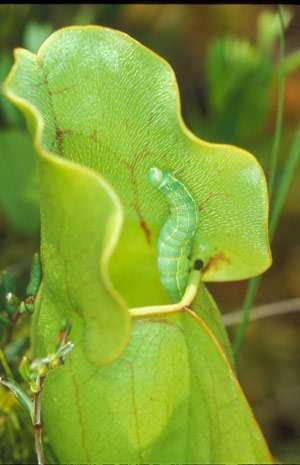
Manipulating ecosystems to affect biodiversity and examine species interactions can be an overwhelming challenge, especially when trying to understand complete food webs. Unless, that is, the ecosystem is less than the size of a teacup. Harvard Forest ecologist Aaron Ellison and University of Vermont biologist Nick Gotelli are generating unexpected insights into food webs by studying the micro-ecosystem of the northern pitcher plant.
Living throughout the Northeast in bogs surrounded by forests, pitcher plants collect rainwater in their vase-like leaves and support an entire food web of tiny organisms. The carnivorous plants produce a nectar that lures ants, spiders, and many other kinds of insects, some of which fall into the tiny “pond” of rainwater. Bacteria, rotifers, mites, mosquito larvae, and other organisms live in this rainwater, and help to break down the ant carcasses, whose nutrients are then absorbed by the plant.
But the pitcher plant is not the top gun in this world. The larvae of three species of moth feed on the pitcher plants, one of which cuts a hole in the pitcher and drains out the water, eliminating the entire food web that nourishes the plant.
To gain a better understanding of the interactions between the predators (the pitcher plants), herbivores (moths), and omnivores (ants) that make up this tiny ecosystem, Ellison and Gotelli have been mapping pitcher plant populations in every New England state, counting nearby ant nests, and determining the spatial relationships between the ants, the moths, and the plants that have been attacked by moths. They have also set up an experiment at the Harvard Forest in Petersham, Massachusetts, where they have transplanted pitcher plants of varying sizes and in different spatial arrangements to learn how the ants and moths respond.
In the second year of the study, the moth larvae began attacking the plants at the edge of the experimental area. The ecologists expect that in succeeding years, they will see a traveling wave of damage across the pitcher plant population, with the moths – which are not strong fliers – laying most of their eggs on the larger plants near where the adults emerged from their pupae. They also expect to find ant populations moving into the area behind the moths, with a lag time of a couple months to a year, as the plants recover from the damage inflicted by the moths.
“There is a notion that habitat size makes a lot of difference for the functioning of food webs, that you need big habitat blocks to support complete food webs,” Ellison said. “We tested this hypothesis using the natural five-level food web of bacteria, protozoa, midge, mosquito, and fly larvae in the pools within the pitcher plants to find out whether different-sized habitats – pools of different volume – changed the number of levels in the food web and the abundance of individual organisms at each level.”
According to Ellison, it was the first time anyone had managed to do this kind of experiment on an entire food web, and their conclusion was somewhat surprising. “It turned out that habitat size was not as important as was the presence of the top predator,” which in this case is the larva of the pitcher plant mosquito.
Next up for Ellison and Gotelli is to assess how the food web is affected when the pitcher plants are arranged in various configurations. Their experiment will shed light on the impact of habitat fragmentation on the functioning of an entire ecosystem, albeit a small one.

